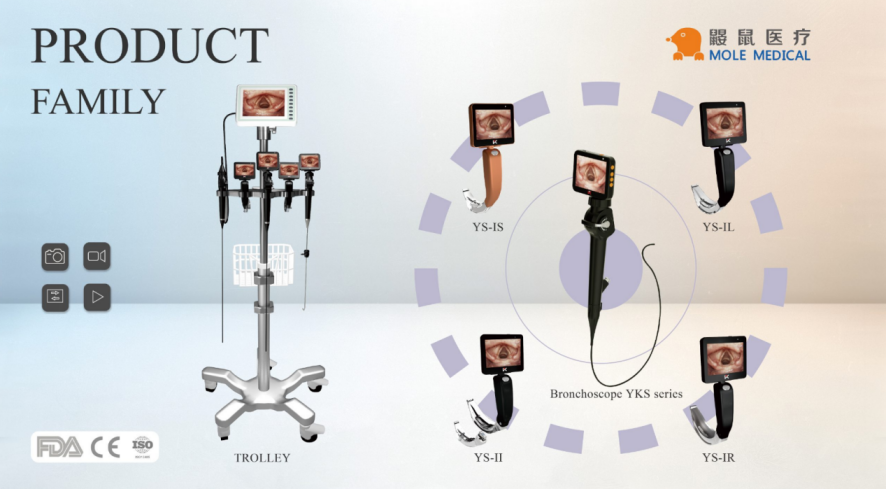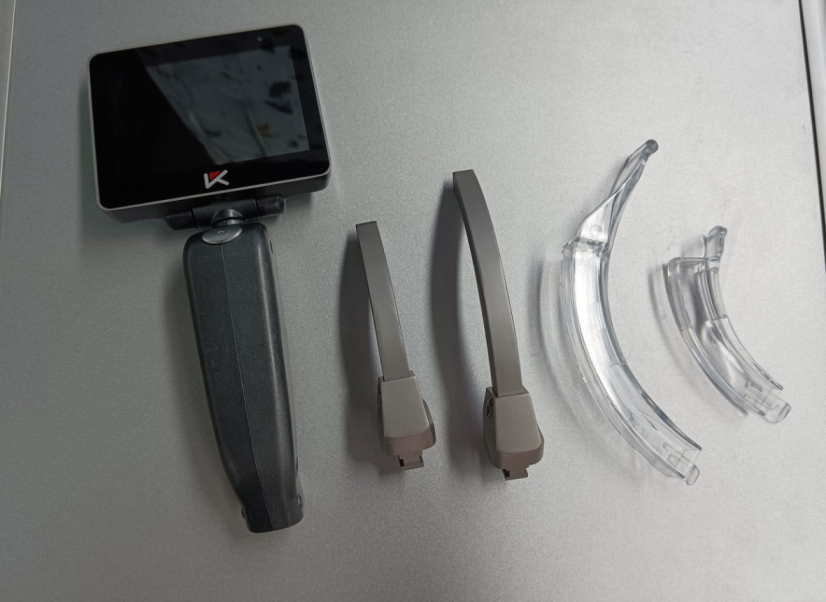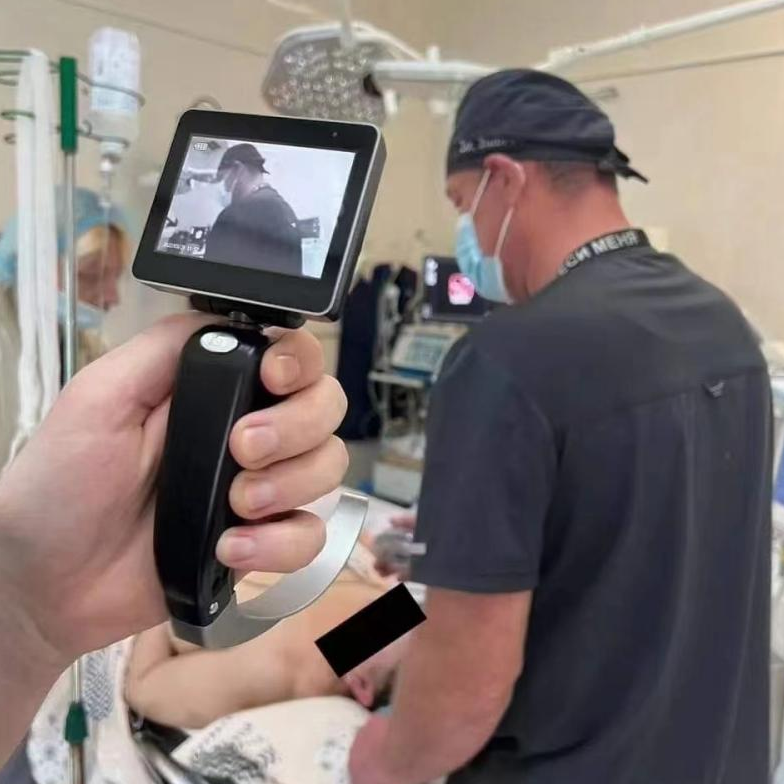Curved or Straight? Analyzing Intubation Blade Types
Sep 26, 2024
In the realm of airway management, making the correct decision regarding which intubation blade to use becomes a vital determinant of whether the procedure will be successful, especially in scenarios involving challenging airway conditions. The two predominant varieties of intubation blades, specifically curved and straight types, each come with their own set of advantages, and grasping the key differences between them holds the potential to significantly influence the difficulty and success rate of intubation procedures. Given that these blades differ in their angles of vision, depth fields, and specialized designs, choosing the right blade becomes indispensable for optimal performance. Mole Medical, a highly regarded supplier of premium Intubation Blade Types, offers a wide array of products tailored to meet the diverse requirements of healthcare professionals.

Fundamental Differences Between Curved and Straight Intubation Blade Types
Design Features and Intended Functions
Curved and straight intubation blades are engineered to fulfill distinct roles in the management of airways. The curved blade, often referred to as the Macintosh blade, is characterized by its smooth, curved design, which allows it to indirectly elevate the epiglottis, thereby offering a more comprehensive view of the glottis during the intubation process. On the other hand, the straight blade, also known as the Miller blade, is specifically designed to directly lift the epiglottis, a function that proves especially effective in patients with difficult airways—such as infants or those with shorter necks.
Selecting between a curved or straight blade is not a one-size-fits-all decision; it hinges on a multitude of factors, such as the patient’s unique anatomy and the clinician’s level of experience with each blade type. The indirect method employed by curved blades typically offers a wider angle of vision, which often benefits adult patients. In contrast, straight blades are often the tool of choice in pediatric cases, given that they afford more precise control over lifting the epiglottis in smaller airways.
The Visual Field and Insertion Depth
A primary distinction between curved and straight blades lies in the scope of the visual field and the depth required for insertion. Curved blades tend to offer a broader visual field, with angles of vision exceeding 73 degrees, which enables clinicians to gain a clearer view of the glottis and adjacent anatomical structures. This expansive visual angle facilitates enhanced visibility and allows for smoother navigation, making the curved blade the preferred option when the patient’s anatomy is straightforward.
Conversely, straight blades offer a narrower visual field; however, they permit more precise handling in difficult airway cases. With a depth range from 20 to 100 millimeters, straight blades provide a highly controlled method of insertion, which becomes particularly advantageous when the clinician needs direct visualization of the glottis. This precision is especially beneficial when treating pediatric patients or those with anatomically complex airways, where directly manipulating the epiglottis becomes essential.

Implications for Patient Comfort and Safety
When it comes to airway management, both curved and straight blades hold important roles, though patient comfort and safety remain paramount. Curved blades generally afford greater comfort for the patient, as their smooth insertion results in minimal trauma to the oral tissues. This makes them an excellent choice for routine intubations where a broad view of the airway can streamline the procedure.
While straight blades may cause some discomfort due to their direct nature, they are indispensable in cases where the patient presents a challenging airway. These blades allow for more precise control over the epiglottis, thereby reducing the likelihood of complications during complex intubations. Choosing the appropriate blade type based on the unique anatomical and airway characteristics of the patient is critical to improving safety and minimizing the risk of trauma during the procedure.
The Influence of Intubation Blade Types Design on Successful Intubation in Challenging Airways
Tailoring the Approach to Individual Airway Characteristics
Blade design plays a decisive role in the outcome of intubation, particularly when managing difficult airways. In complex cases—such as patients who have a large tongue, a short neck, or restricted neck mobility—the choice between a curved or straight blade can be the determining factor between a successful or failed intubation. Specially engineered blades for difficult airways, such as Mole Medical’s tilting tip blades, offer enhanced maneuverability and precision, empowering clinicians to navigate even the most intricate airway anatomies.
Curved blades, with their wider angles of vision and indirect insertion, often serve as the preferred option when managing difficult airways in adult patients. These blades provide a more expansive view of the glottis and facilitate smoother insertion in scenarios where visibility is compromised. However, in patients with anatomical abnormalities, a straight blade may offer superior control by allowing the clinician to lift the epiglottis directly, thereby securing the airway with greater efficiency.
The Game-Changing Role of Tilting Tip Blades
Tilting tip blades, a groundbreaking development for managing difficult airways, are one of the many innovative products offered by Mole Medical. These specialized blades feature an adjustable tip that can be manipulated to improve access to the glottis in even the most challenging cases. This innovation allows clinicians to attain ideal visualization and positioning, minimizing the need for forceful maneuvers or repeated intubation attempts.
Tilting tip blades prove especially advantageous in situations where conventional curved or straight blades fail to provide sufficient access. For example, in patients with anterior airways or when a higher degree of precision is necessary, the tilting tip blade offers the flexibility required for successful intubation, while ensuring patient safety. Additionally, these blades help mitigate the risk of airway trauma by enabling smoother and more controlled insertions.
The Importance of Intubation Blade Types Size in Managing Difficult Airways
Another critical component in successful intubation, particularly when dealing with difficult airways, is selecting the correct blade size. Mole Medical offers a broad range of blade sizes across eight different models to accommodate the varied anatomical needs of patients. Using the correct blade size ensures maximum visibility and control during intubation, which in turn helps to reduce complications and improve patient outcomes.
Mastering the Blade Size Chart for Effective Airway Management
Why Blade Size Matters in Airway Management
Choosing the proper blade size is a key factor in successful airway management. An intubation blade that is too large could cause unnecessary damage, whereas one that is too small may not provide sufficient visibility or control. Mole Medical’s comprehensive blade size chart offers clinicians valuable guidance for selecting the appropriate blade for each patient, ensuring that the intubation procedure proceeds smoothly and safely.

Blade size should always be matched to the individual patient’s anatomy, with considerations given to variables such as mouth size, neck length, and the complexity of the airway. For instance, larger blades may be required for adult patients with a broad mouth or wider airway, whereas smaller, more delicate blades are typically needed for pediatric patients. Familiarity with the blade size chart is crucial for healthcare professionals aiming to make well-informed decisions that optimize patient outcomes.
Addressing Pediatric Airway Challenges with the Right Intubation Blade Types Size
Airway management in pediatric patients presents unique difficulties that demand careful blade size selection. The smaller, more delicate anatomy of children often necessitates the use of straight blades, which are generally better suited to handling narrow airways. Mole Medical’s pediatric blade range provides clinicians with the tools necessary to achieve successful intubations in younger patients, minimizing the potential for trauma or injury.
Matching blade size to the pediatric patient’s age, weight, and airway anatomy is particularly important. Mole Medical’s user-friendly size chart enables clinicians to rapidly identify the appropriate blade for each pediatric case, ensuring that the intubation process is both effective and safe.
Blade Size’s Impact on Visibility and Control
The size of the blade has a direct influence on the clinician’s ability to visualize the airway and maintain control during the intubation process. Larger blades offer a broader visual field and greater depth, facilitating easier navigation in adult patients. However, in smaller patients or those with complex anatomical structures, a smaller blade may afford superior precision and control.
Understanding how blade size influences both visualization and control is crucial for effective airway management. Clinicians well-versed in the blade size chart can make quick, informed choices that lead to better patient outcomes, especially in urgent or complicated scenarios.
Adapting Intubation Techniques for Different Intubation Blade Types
Adjusting Techniques for Curved Blades
When using a curved blade, clinicians must tailor their intubation technique to leverage the blade’s indirect approach. The curvature of the blade facilitates a gradual insertion, with the tip positioned in the vallecula to lift the epiglottis indirectly. This method offers a wider view of the glottis, allowing the clinician to more easily position the endotracheal tube with minimal risk of trauma.
Modifying Techniques for Straight Blades
The use of straight blades necessitates a different approach, with the blade tip positioned beneath the epiglottis to achieve direct lifting. This technique proves especially valuable in pediatric cases and in patients with difficult airway anatomy, as it grants greater control over the epiglottis and improves visualization in challenging situations. Precision is key when employing straight blades, as any misstep could result in damage to the oral tissues, thereby complicating the intubation process.
Utilizing Tilting Tip Blades for Greater Flexibility
Tilting tip blades provide clinicians with a unique advantage, offering the ability to adjust the blade’s tip to gain superior access to the glottis. This flexibility proves invaluable in cases involving difficult airways, where conventional blades may fall short. Clinicians must familiarize themselves with the adjustable features of tilting tip blades to fully harness their potential, but once mastered, these blades can substantially improve success rates in complex intubations.
Conclusion
In conclusion, selecting the ideal Intubation Blade Types—whether curved or straight—requires a comprehensive understanding of both the blade’s design and the patient’s airway anatomy. Mole Medical’s extensive selection of intubation blades, including tilting tip models and various blade sizes, provides healthcare professionals with the versatility necessary to manage a wide array of airway challenges effectively. By adapting intubation techniques and choosing the appropriate blade for each patient, clinicians can ensure a higher standard of safety and success in airway management.
Categories
Latest Articles

Disposable Nephroscopes: Redefining Safety & Efficiency in Urology
Introduction The shift towards minimally invasive urological surgery has found a pivotal ally: the disposable nephroscope. As traditional reusable scopes grapple with persistent biofilm contamination risks and soaring sterilization costs, the global medical community is rapidly adopting single-use solutions. This article analyzes the clinical value, technological evolution, and dynamic innovation landscape driving this transformative shift. ... Read more

Disposable Video Laryngoscope Blades: The Ultimate Solution for Preventing Cross-Contamination
In the operating room, as the cold light of a video laryngoscope illuminates a patient’s airway, an age-old medical challenge is being redefined: How can life-saving instruments avoid becoming vectors of infection? Jiangsu MoleMedical drives an innovative safety revolution—replacing reusable devices with single-use, sterile laryngoscope blades that create a pure barrier for critical airways. Traditional video ... Read more
-2.jpg)
FDA & CE Approved Video Laryngoscope: What Makes It Stand Out?
Introduction In high-pressure emergencies and precision-driven operating rooms, video laryngoscopy is revolutionizing airway management. Mole Medical’s FDA and CE-certified technology replaces tactile-dependent “blind intubation” with real-time visual navigation – enhancing safety, accuracy, and clinical outcomes worldwide. Why Certification Matters Mole Medical’s dual certifications validate its global compliance and performance: FDA Clearance: Rigorous validation of safety/efficacy ... Read more

Mole Medical Showcases Advanced Endoscopy Solutions at CMEF Autumn 2025, Driving Global Partnerships
Guangzhou, China – September 26-29, 2025 – The 92nd China International Medical Equipment Fair (CMEF Autumn) concluded successfully on September 29th at the Canton Fair Complex in Guangzhou. Mole Medical Technology Co., Ltd. (Mole Medical) made a significant impact at the event, drawing global medical professionals and partners to its booth (Hall 2.1, Stand Q24) ... Read more

How to Use Disposable Ureteroscopes Safely and Efficiently
In the field of urology, the application of disposable electronic ureteral-kidney pelvis endoscopy catheters is leading the technological innovation in minimally invasive surgeries. According to the 2024 multi-center research data from China’s urology department, among the over 5,000 surgeries included, the patient group using disposable catheters performed significantly better in key indicators such as operation ... Read more



